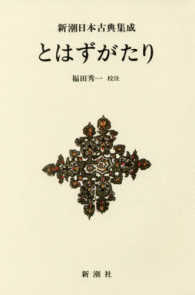- ホーム
- > 洋書
- > 英文書
- > History / World
Full Description
How did people in East Africa come to see themselves as 'Africans,' and where did these concepts originate from? Utilizing a global intellectual history lens, Ethan Sanders traces how ideas stemming from global black intellectuals of the Atlantic, and others, shaped the imaginations of East Africans in the early twentieth century. This study centers on the African Association, a trans-territorial pan-Africanist organization that promoted global visions of African unity. No mere precursor to anti-colonial territorial nationalism, the organization eschewed territorial thinking and sought to build a continental African nation from the 1920s to the 1940s, at odds with later forms of nationalism in Africa. Sanders explores in depth the thought of James Aggrey, Paul Sindi Seme, and Julius Nyerere, three major twentieth-century pan-Africanists. This book rethinks definitions of pan-Africanism, demonstrating how expressions of both practical and redemptive pan-Africanism inspired those who joined the African Association and embraced an African identity.
Contents
Introduction; 1. Ethiopianism, redemptive pan-Africanism, and the African nation in the thought of James Aggrey; 2. Local and regional influences in creating a pan-African political program; 3. Building the African nation: Paul Sindi Seme and the creation of a pan-African network, Zanzibar and the Mainland, 1935-1946; 4. African identity and practical pan-Africanism in the African association; 5. African identity and practical pan-Africanism among the women of the African association; 6. Competing nationalisms and shifting loyalties: the creation and dissolution of the African association's pan-African project; 7. Uafrika na Umoja: the African political thought of Julius Nyerere; Conclusion; Select bibliography; Index.
-

- 和書
- #10年後泣くやつ
-

- 電子書籍
- 河(下) 【小田実全集】






